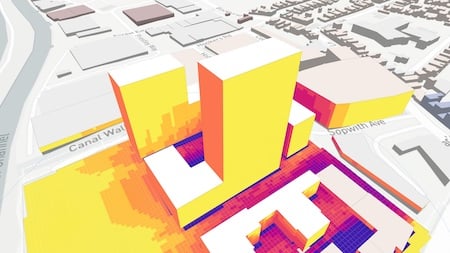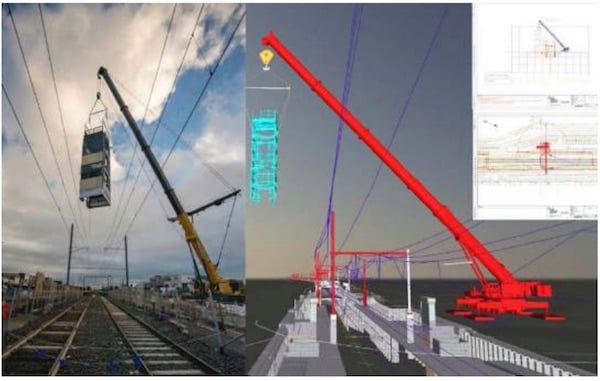
For building designers, some of the most challenging and time-consuming work occurs during conceptual design — when broad visions of a building’s function and form are articulated in a way that can later be advanced into more detailed designs. Historically, the process has started with paper sketches. With technological advances, an increasing amount of conceptual design has been done with electronic sketching tools, diminishing the use of paper sketches.
In recent years, AEC firms and software developers have been pursuing new ways to automate the conceptual design process, reducing time spent on repetitive tasks and freeing up designers to focus on more creative work. Seeking more than just electronic sketching tools, AEC professionals have been finding ways to generate multiple design options faster, accelerating project development. Some AEC firms have developed in-house tools, while others have turned to commercial software developers.
Leveraging Project Data
Atlanta-based software developer Blue Ocean Sustainability launched a cloud-based product earlier this year that leverages previous project data to accelerate the conceptual design process. While not the first 3D conceptual design tool on the market, Skema enables users to access custom catalogs of data from their firm’s previous projects to quickly create multiple solutions, adjust them graphically, and generate editable BIM data that can be used downstream in the design process.
“It’s a conceptual design environment coupled with a BIM automation engine,” said Marty Rozmanith, chief technical officer and co-founder of Blue Ocean. “We’re taking virtual chunks of data and using that to speed up the design process.” In previous positions, Rozmanith was AEC sales director at Dassault Systèmes and director of product management at Revit Technology Corp., later acquired by Autodesk.
Skema enables architects to create different unit mixes that fit in a massing (left) and create blocking and stacking cubes based on previous project data (right). Image source: Blue Ocean Sustainability.
By harvesting data from previous projects, Skema is able to “reconstitute a high level of BIM data” during conceptual design and generate blocks and stacks that can be moved forward through design development into construction drawings, according to Rozmanith. The blocking and stacking approach is often used by architects and property developers to assign floor area locations for tenants.
Using guidelines established from previous projects, Skema can establish exiting, circulation, and room configurations in multi-family housing units and other buildings. The data within the blocks and stacks can be used to create level of development (LOD) 350 data in Revit and other BIM software. The American Institute of Architects (AIA) defines LOD levels ranging from 100 to 500, with LOD 350 describing information about an element precisely and outlining an element’s relation and connection with other components.
Rozmanith said Blue Ocean has no plans for Skema to generate LOD 500 (final design) data. “Our goal is to be the fastest way to get to 60% complete on a project,” he said. “We want to eliminate all the boring, repetitive drudgery.” From that point, architects and other building professionals can perform preliminary and final design just as they would on other projects, he noted.
In addition to generating conceptual designs, Skema can perform various analyses at the site and building level. For environmental and sustainability analyses, Skema can analyze daylight and sunlight reaching various faces of a building and generate color-coded models.
Skema can perform daylight and sunlight analyses to aid environmental and sustainability design. Image source: Blue Ocean Sustainability.
Blue Ocean has also partnered with software developer cove.tool to integrate some of the cove.tool building analysis functionality with Skema. For example, users can run cove.tool daylight analyses based on Skema-generated geometry and display the results in Skema. “It's a demonstration of how a web-based workflow in the cloud between two web apps. . . can make the overall workflow better for the user,” noted Rozmanith.
While Skema was developed with residential building projects in mind, the methodology is extensible to other building types, such as medical office buildings, clinics, and schools, according to Rozmanith. Future plans include generating preliminary structural design data, such as sizing of concrete, steel, and mass timber members.
Blue Ocean pioneer partners have full Revit interoperability with BIM LOD 350-as-a-service. Image source: Blue Ocean Sustainability.
AEC Firm Finds Value
For architecture and interior design firm TVS, Skema is addressing a company goal to expedite design processes with digital tools. The company had been developing conceptual design tools in-house, but hadn’t reached the level of sophistication available in Skema, according to Michael Hodge, the firm’s digital practice quality principal. “We saw Skema directly in line with what we were developing [but more advanced],” noted Hodge. “We had been looking at: how could we expedite the design process by way of design assistance tools?”
TVS signed on as a pioneer partner with Blue Ocean, which enabled TVS to share previous project data and develop catalogs for designing future projects, as well as help guide future development of Skema. “We saw an opportunity to take the relationship forward. We could be a part of development and evolution of Skema,” Hodge said.
Based on early testing, Hodge sees Skema drastically reducing the time spent on conceptual design. In a workshop with Blue Ocean, a team of TVS professionals used Revit data from similar TVS projects to develop multiple conceptual designs on a test project. With designers from different TVS studios participating, the group created and iterated multiple concept schemes. The results were eye opening. “You can do in a day what would have taken weeks [with previous methods],” noted Hodge. “It not only gives you a conceptual model; you can also skin and envelope that building quickly and move that back into Revit.”
Two TVS studios are now evaluating how to apply Skema on active projects and make it part of primary design workflows. In addition to the firm’s multifamily housing design, Hodge sees Skema applicable to other areas, such as healthcare and mixed-use development. In the firm’s healthcare studio, Skema gained acceptance at the principal level, which led to supporting young professionals to work with Blue Ocean to adapt it to their market sector.
“As an entry-level designer, sometimes it is difficult to see my work in our drawings making a difference in the world around me,” said TVS design professional, Karissa Beveridge. “Using Skema will give me a greater design agility, reduce repetitive tasks, and allow me to more quickly make a meaningful difference in the design of large-scale healthcare spaces.”
Altering Workflow
Tools such as Skema are clearly altering the workflow of building design, and will continue to do so. Other conceptual design tools on the market include: Archistar from Archistar Pty. Ltd.; Delve from Sidewalk Labs, a Google unit; Podium from real estate developer/contractor Lendlease; Snaptrude from Snaptrude Inc.; and Codesign, an iPad app from Cerulean Labs. Other AEC industry firms have also developed various custom tools in-house or in combination with commercially available products.
The ability to shave significant time off conceptual design work also presents interesting scenarios for architects and other building professionals. Will clients become accustomed to this capability and expect faster delivery with potentially lower design fees? Or will designers be able to apply their resources elsewhere and enhance designs more creatively without decreasing overall fees? These are questions AEC firms have encountered ever since digital technology first impacted the industry. Based on previous patterns, tech-savvy firms will probably want to at least have the new conceptual capabilities in their toolboxes, and they may have to figure out the business implications along the way.
Andrew G. Roe
Cadalyst contributing editor Andrew G. Roe is a registered civil engineer and president of AGR Associates. He is author of Using Visual Basic with AutoCAD, published by Autodesk Press. He can be reached at editors@cadalyst.com.
View All Articles








Share This Post